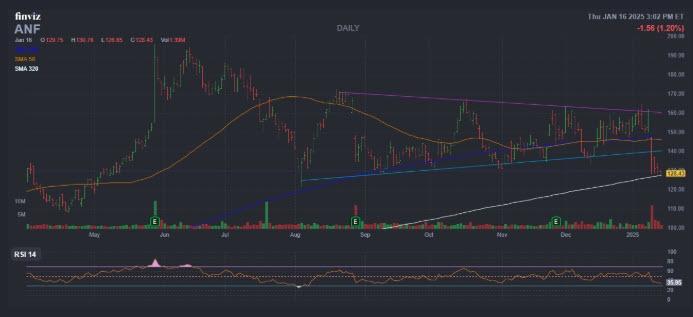Abercrombie & Fitch (ANF), after experiencing a period of robust growth in 2023, encountered a significant downturn in its stock price following the release of its fiscal-year guidance, which fell short of market expectations. Despite strong holiday sales and sustained consumer demand, the company’s projected outlook triggered a substantial sell-off, plummeting the stock price by 15.7% in a single day, marking its most significant single-session decline since August. This sharp drop brought the stock to its lowest point since May, raising concerns among investors. However, several technical and market indicators suggest a potential rebound for ANF, making it an attractive prospect for contrarian traders.
One key indicator is the stock’s proximity to its 320-day moving average, a historically bullish trendline for ANF. Historical data reveals that in the past three years, whenever ANF has approached this moving average under specific conditions – namely, trading above the average for 80% of the time over the preceding two months and closing above it for eight of the last ten sessions – the stock has subsequently experienced an average 10.3% return within a month. This pattern suggests that the current pullback may be a temporary dip, offering a buying opportunity for investors. Furthermore, the potential formation of a “golden cross” – a bullish breakout pattern occurring when the 50-day moving average crosses above the 200-day moving average – further strengthens the case for a potential upswing.
Adding to the contrarian perspective is the stock’s current oversold condition. The 14-Day Relative Strength Index (RSI), a momentum indicator, has dropped to 35, its lowest point since August, suggesting the stock may be oversold and ripe for a price correction. This low RSI, coupled with the stock’s significant decline, indicates a potential overcorrection in the market, presenting a favorable entry point for investors. Despite the bearish sentiment prevailing in the market, the possibility of a short squeeze adds another layer of intrigue to ANF’s potential rebound.
While short interest has declined recently, a substantial 4.33 million shares – representing 8.8% of the company’s available float – are still sold short. This indicates a vulnerable position for short sellers, as a sudden surge in buying pressure could trigger a short squeeze, forcing them to cover their positions and further propelling the stock price upward. The current market dynamics, characterized by bearish sentiment and oversold conditions, create an environment conducive to such a scenario.
Furthermore, the options market presents an attractive avenue for investors seeking to capitalize on ANF’s potential rebound. The stock’s Schaeffer’s Volatility Index (SVI) of 48% is relatively low compared to the past year, indicating that options prices are not excessively inflated. This presents a favorable opportunity for option buyers, as they can potentially acquire options contracts at relatively lower premiums. Moreover, ANF’s Schaeffer’s Volatility Scorecard (SVS) of 17 out of 100 suggests that the stock is underpriced relative to its expected volatility, further reinforcing the case for option strategies.
In conclusion, while ANF’s recent performance has been disappointing, several converging factors suggest a potential turnaround. The historical bullish trend associated with the 320-day moving average, the potential formation of a “golden cross,” the oversold RSI, the possibility of a short squeeze, and attractive options pricing all paint a picture of a stock poised for a rebound. For contrarian investors, this confluence of positive indicators presents a compelling opportunity to capitalize on the market’s overreaction and potentially reap significant rewards as ANF recovers from its recent slump. However, as with any investment, careful consideration of the risks and potential rewards is crucial before making any decisions. Market conditions can change rapidly, and past performance does not guarantee future results. Therefore, conducting thorough due diligence and consulting with a financial advisor is always recommended.

